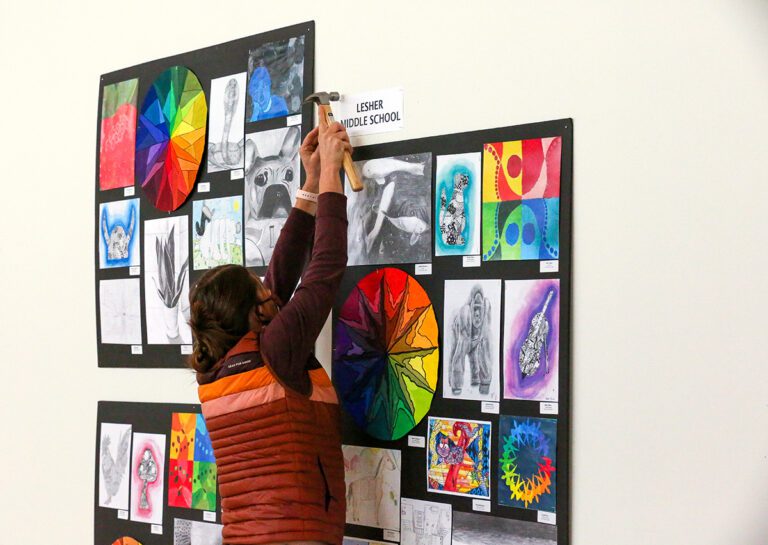Are you thinking about what to do the first week of school to quickly get art up in the hallways? Do you need a way to get students creating but still have them practice classroom procedures? You can easily meet both of these goals during the first week of school by creating an art advocacy display.
Check out these 3 ways to create an art advocacy display with your students the first week of school!
1. “Art Is…” Post-it Notes

While Post-it notes are an essential office supply, they are also great for art projects. In this activity, your students will get to practice the routines and procedures for being dismissed from their tables, lining up, and being in the hallway while others are learning.
Materials
- A variety of colorful Post-it notes
- Pencils
- Sharpies
- Markers
Procedures
- Start with a short discussion about why your students think art is important. This helps get students into the right mindset for this project.
- Tell students they are going to write a response to the prompt, “Art is…”
- Let students grab a sticky note and write their response on it.
- Have students hang their notes in the area you’ve designated for display. Make sure you’ve included an “Art is…” sign, so viewers understand what they’re viewing. Hanging the notes right away ensures they will be sticky. If you stick them all together with plans to hang them later, you might be disappointed with the adhesive.
- Have students spend a few minutes reading their classmates’ responses.
For the highest impact, have students arrange their notes in a large square or rectangle. Use a variety of bright colors to catch people’s attention!
2. Advocacy Posters

Posters are a great way to get attention and share information. Students can use a variety of materials in the classroom to create their own posters communicating the importance of art. Students could work individually or in pairs.
This activity will also allow your students to practice your routines for gathering and putting away various supplies.
Materials
- 9″ x 12″ white drawing paper
- Pencils
- Markers
- Crayons
- Watercolors
- Sharpies
- Rulers
Procedures
- Start with a class discussion about why art is important. Try a few essential questions like, “How does art benefit society?” and, “Why is art important to you?”
- Once you have discussed the importance of art, tell students they will be creating an informational poster to share with others. Tell students to get creative and list at least three to five reasons why art is important through images and text.
- Give students their paper. You can let students work individually or pair them up.
- Make sure to have students practice how to get and return supplies according to your classroom procedures.
- At the end of class, collect the posters. Display them around the school or all together in a large collaborative display.
3. Group Banner

If you want to practice collaboration, have your students create banners to place in areas with large wall space around your school.
Materials
- Sketch paper
- Butcher/roll paper (your desired length)
- Markers
- Crayons
- Colored pencils
- Sharpies
- Tempera/acrylic paint
Procedures
- Before you begin, make sure students have a basic understanding of working with classroom supplies. Make sure they know how to get the supplies as well as put them back. Cleanup will be a great time to re-teach if needed.
- Have students talk to their table groups about why art is important to them and the world. You can give them a piece of sketch paper to write down their responses.
- Tell students they are going to work together to create a banner to share the importance of art.
- Let students work together to create with drawing and/or painting supplies. They can choose which supplies they want from the options you give them.
- Have students hang their banners in the school.
Each of these activities promotes art advocacy and allows students to take part in sharing their personal views toward art education. This is a great way to spark conversations in school, bring awareness to your art program, and advocate for art overall.
How do you use art lessons to promote art advocacy?
What is your favorite lesson for the first week of school?
Magazine articles and podcasts are opinions of professional education contributors and do not necessarily represent the position of the Art of Education University (AOEU) or its academic offerings. Contributors use terms in the way they are most often talked about in the scope of their educational experiences.





